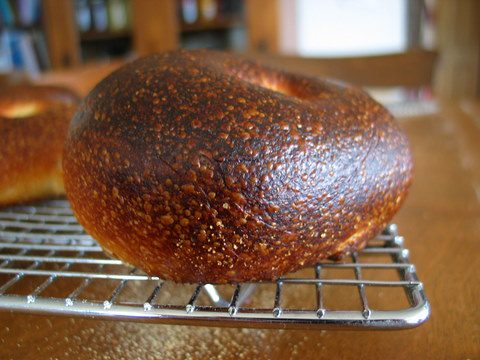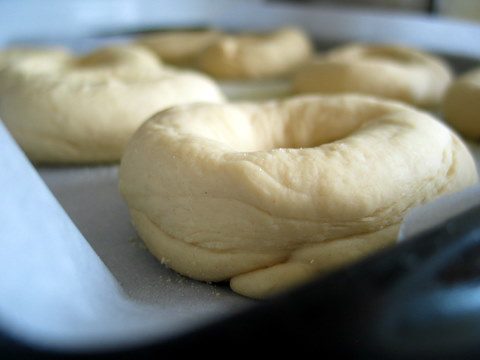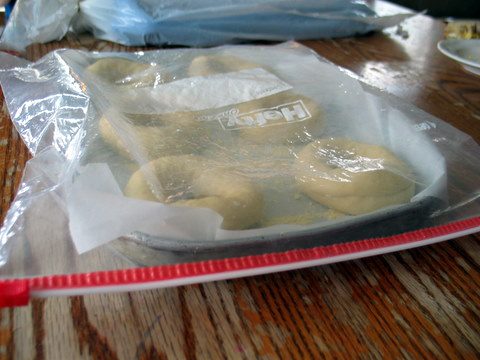
Burnished. This was the word that popped into my mind when I made these bagels. If someone could’ve seen inside my head, they would’ve thought me certifiably psycho: They are soooo burnished! Shiny and burnished…glossily burnished. Sleekly and sexily burnished. Buuurnished.

These, hands down, are the best bagels I have ever made.

I have another recipe for bagels of the commercial yeast variety, and even though I like them a lot, invariably some of the bagel bottoms end up dense and gummy, like noodles. But these, well. I had not a single—not a single!—flop.

We tore into them while they were still warm. At first I was disappointed because the texture was more bread-like then chewy bagel-like. But after the bagels cooled to room temperature and sat for several hours, they transformed into delicious burnished chewy-nesses. And by day two they were even chewier.

This is one of the faster sourdough recipes. Just throw all the ingredients in the mixer (the recipe calls for a lot of starter, which is always a plus in my book because then I can get away with making just one recipe for the day and don’t have to feel like I need to make a variety of different breads just so I can use up all the starter), knead it for eight minutes, shape the bagels (it’s actually a fun activity and not a chore at all), put them on two trays, cover them well, and transfer them in the refrigerator to proof till the next day when it’s time to boil and bake them. After a brief dip in a pot of boiling water and fifteen minutes in a hot oven, they are done.

I will be making these beauts every time I do a round of sourdough baking. They are an essential bread, one I’ve resolved to have on hand at all times.
Bagels
Adapted from Nancy Silverton’s Breads from the La Brea Bakery
Update September 10, 2022: I think the bagels need more salt. Might want to consider increasing to 4 teaspoons.
Update October 13, 2022: this recipe is easier, faster, better!
12 ounces (1 ½ cups) cool water
2 teaspoons yeast
13 ½ ounces (1 ½ cups) white starter
2 pounds (6 ½ cups) high-gluten flour or white bread flour
6 tablespoons wheat gluten (if not using high-gluten flour)
1/4 cup sugar
4 teaspoons salt
2 tablespoons barley malt syrup
6 tablespoons milk powder
Day One:
Put all the ingredients in your standing mixer and mix on low speed for one to two minutes. Turn the mixer up to medium speed and mix for another 8 minutes, or until a thermometer reads 75 degrees when plunged into the dough. Let the dough rest for ten minutes.
Line two baking sheets with parchment paper and sprinkle them with cornmeal or semolina flour.
Divide the dough into 18 four-ounce pieces. Roll each lump of dough into a 6-8 inch rope, then loop it around so that the ends overlap by about 1-2 inches. With the fat overlapping part of the bagel in the palm of your hand and the skinny part of the bagel over the back of your hand, press your hand down on the counter and roll back and forth, pressing the bagel ends together. (It’s much easier than it sounds.) Repeat with all the lumps of dough.

Place the shaped bagels on the prepared baking sheets, leaving an inch or two between each bagel.

Slip the sheets of bagels into a large bag, tie it shut, and put them in the refrigerator to proof for 12-24 hours.

Day Two:
Remove the bagels from the refrigerator, uncover them, and let them proof at room temperature for about 20 minutes.

Put about four inches of water in your widest (not deepest) kettle and bring it to a boil. (You may want to add something to the water to enhance the bagels, but it isn’t necessary. Brown sugar, baking soda, or salt are the most common additions, I think.) At the same time, preheat your oven (and baking stone, if using) to 450 degrees.
When the water is rapidly boiling, gently drop in three or four bagels. Boil for 20 seconds on each side, flipping them over with a slotted spoon.

Carefully remove the bagels, one at a time, from the water and place them, smooth side up, on the preheated baking stone (that you generously dusted with cornmeal after heating). Once your baking stone is filled, bake the bagels for 15-20 minutes.

Wait to boil the remaining bagels until the first batch is out of the oven since it is important to get the bagels out of the boiling water and into the oven as quickly as possible—you don’t want the boiled bagels to sit around at room temperature for too long.
They keep well at room temperature for two or three days. If freezing, cool completely before bagging.
Note: I’m submitting this post to Yeast Spottings.









